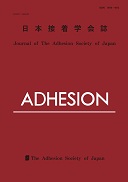All issues

Volume 36, Issue 11
Displaying 1-5 of 5 articles from this issue
- |<
- <
- 1
- >
- >|
Review
-
Takafumi IIDA2000 Volume 36 Issue 11 Pages 464-470
Published: November 01, 2000
Released on J-STAGE: April 30, 2015
JOURNAL FREE ACCESSDownload PDF (1993K)
Review
-
Masaki KIMOTO2000 Volume 36 Issue 11 Pages 456-463
Published: November 01, 2000
Released on J-STAGE: April 30, 2015
JOURNAL FREE ACCESSDownload PDF (2764K)
Original Paper
-
Toshio OGAWA, Naoki TOMONO, Satoshi OHSAWA, Tomoyuki SATOU2000 Volume 36 Issue 11 Pages 449-455
Published: November 01, 2000
Released on J-STAGE: April 30, 2015
JOURNAL FREE ACCESSThe surface modification of low density polyethylene (LDPE) sheet was carried out by coronadischarge treatment under various humidities. The adhesive strength was measured by a peel testfor the laminated film composed of LDPE with polyethylene-terephthalate(PET). The adhesivestrength be came strong with the increase of humidity and reached the maximum. However,it was found that too much humidity would make the adhesive strengthweak, and therefore thereis the most appropriate humidity. The adhesive strength reached over 1000N/m when both ofLDPE and PET were treated under high humidityView full abstractDownload PDF (2067K)
Original Paper
-
Hajime KIMURA, Kazuhisa TASHIRO, Akihiro MATSUMOTO2000 Volume 36 Issue 11 Pages 442-448
Published: November 01, 2000
Released on J-STAGE: April 30, 2015
JOURNAL FREE ACCESSTwo kinds of phenol-ovolac based benzoxazine having different molecular weights weresynthesized. Glass fiber reinforced plastic (GFRP) was prepared using the molten mixture fromthe above benzoxazines and bisoxazoline as a matrix, and the effect of molecular weight ofbenzoxazines on the properties of GFRP was investigated. As a result, GFRP from the benzoxazinehaving largermolecular weight as a matrix showed higher heat resistance because of highercrosslink density. And GFRP from the benzoxazine having lower molecular weight as a matrix showed higher tensile, flexural and especially impact strength. The reason was considered as follows: in the case of the benzoxazine having lower molecular weight as a matrix, matrix wasso flexible due to lower crosslink density, and interfacial bonding strength between matrix and fiber was so low that stress concentration in matrix was easy to relax.View full abstractDownload PDF (2074K)
Original Paper
-
Hiroshi MASAOKA, Shigeo KOHMOTO, Makoto YAMAMOTO2000 Volume 36 Issue 11 Pages 435-441
Published: November 01, 2000
Released on J-STAGE: April 30, 2015
JOURNAL FREE ACCESSThe microscopic study suggested that the destruction of aluminum hydroxide filled acrylic composite proceeded inside of the particle. Therefore, the protection of the brittle particle from the cleavage was important for toughening of this system. This purpose was achieved by addition of newly prepared carboxyl terminated unsaturated polyesters having flexible segment to the composite. These polyesters contained both carboxyl and vinyl groups, therefore they were absorbed selectively by the basic surface of aluminum hydroxide and gave the elastic layer by crosslinking. In addition, these modifiers were copolymerized with the matrix acrylic resin, and hence the strong adhesion between the elastic layer and the matrix toughened the composite more effectively. Consequently, this work provided the concept for toughening of aluminum hydroxide filled acrylic composite, and proposed an efficient toughening method. The effect of these impact modifiers was detected at the fracture surface of the composite and characterized by scanning electron microscope (SEM) observation and element alanalysis which were given by energy-dispersed X-raymicro-analyzer equipped with the SEM (SEM-EDX analysis).View full abstractDownload PDF (2452K)
- |<
- <
- 1
- >
- >|